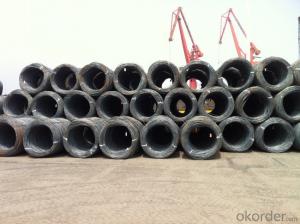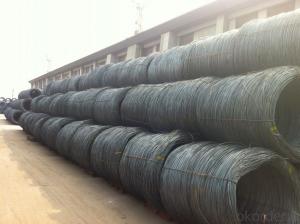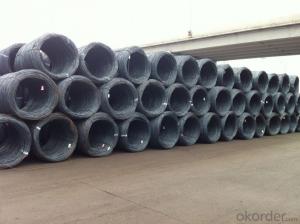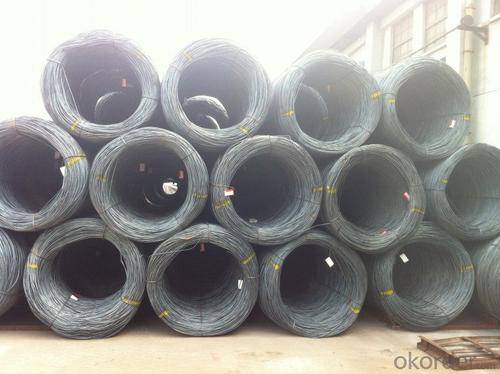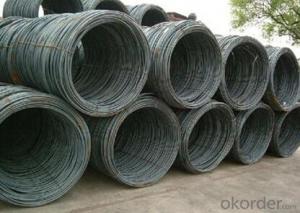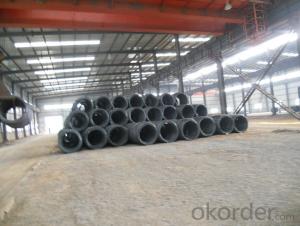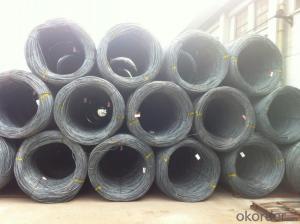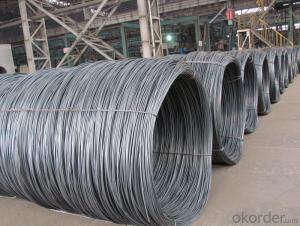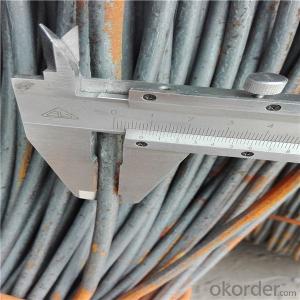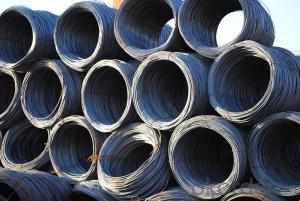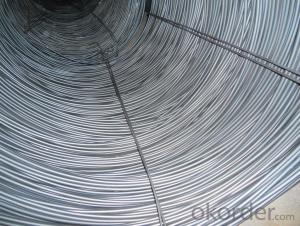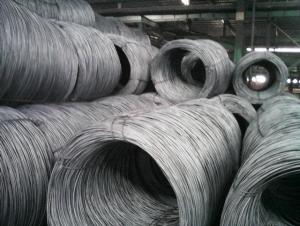Hot Rolled Wire Rods with SAE 1008 in Best Quality
- Loading Port:
- Tianjin
- Payment Terms:
- TT OR LC
- Min Order Qty:
- 25 m.t.
- Supply Capability:
- 10000 m.t./month
OKorder Service Pledge
OKorder Financial Service
You Might Also Like
Product Description:
OKorder is offering Carbon Steel Wire Rod at great prices with worldwide shipping. Our supplier is a world-class manufacturer of steel, with our products utilized the world over. OKorder annually supplies products to European, North American and Asian markets. We provide quotations within 24 hours of receiving an inquiry and guarantee competitive prices.
Product Applications:
Carbon Steel Wire Rod are ideal for structural applications and are widely used in the construction of buildings and bridges, and the manufacturing, petrochemical, and transportation industries.After hot-rolled the products shaped into coil and delivery as finished product, including round, square, rectangular, hexagonal and so on. Since most of the products are round, it is generally called wire rod. Carbon steel wire rod is widely used in construction and manufacturing. Carbon steel wire rod is mainly used for reinforcement of reinforced concrete and welded structure or reprocessed (roberts , nail, etc.) materials, especially used to produce wire drawing, welding electrode, nails, spring, electronic, precise machinery parts and so on.
Product Advantages:
OKorder's Carbon Steel Wire Rod are durable, strong, and resist corrosion.
Main Product Features:
· Premium quality
· Prompt delivery & seaworthy packing (30 days after receiving deposit)
· Corrosion resistance
· Can be recycled and reused
· Mill test certification
· Professional Service
· Competitive pricing
Product Specifications:
Chemical Composition:
Please kindly find our chemistry of our material based on SAE1006/SAE1008 as below for your information
Grade | Chemical Composition (%) | |||||
C | Mn | S | P | Si | B | |
SAE1006B | 0.03~O.07 | 0.32max | 0.045max | 0.040max | 0.30max | 0.0008min |
Mechanical properties | ||||||
Yield strength(N/mm2) | Tensile strength(N/mm2) | Elongation (%) | ||||
250-280 | 350-380 | ≥32 | ||||
Grade | Chemical Composition (%) | |||||
C | Mn | S | P | Si | B | |
SAE1008B | 0.10max | 0.3~0.50 | 0.050max | 0.040 max | 0.15max | 0.0008 min |
Mechanical properties | ||||||
Yield strength(N/mm2) | Tensile strength(N/mm2) | Elongation (%) | ||||
≥195 | 315-430 | ≥30 | ||||
FAQ:
Q1: Why buy Materials & Equipment from OKorder.com?
A1: All products offered by OKorder.com are carefully selected from China's most reliable manufacturing enterprises. Through its ISO certifications, OKorder.com adheres to the highest standards and a commitment to supply chain safety and customer satisfaction.
Q2: How do we guarantee the quality of our products?
A2: We have established an advanced quality management system which conducts strict quality tests at every step, from raw materials to the final product. At the same time, we provide extensive follow-up service assurances as required.
Q3: How soon we can delivery the goods ?
A3: We have a mill with 20000mts of capacity per month. We can delivery the goods within in one month ,as long as your order quantity less than 20000mts
Image
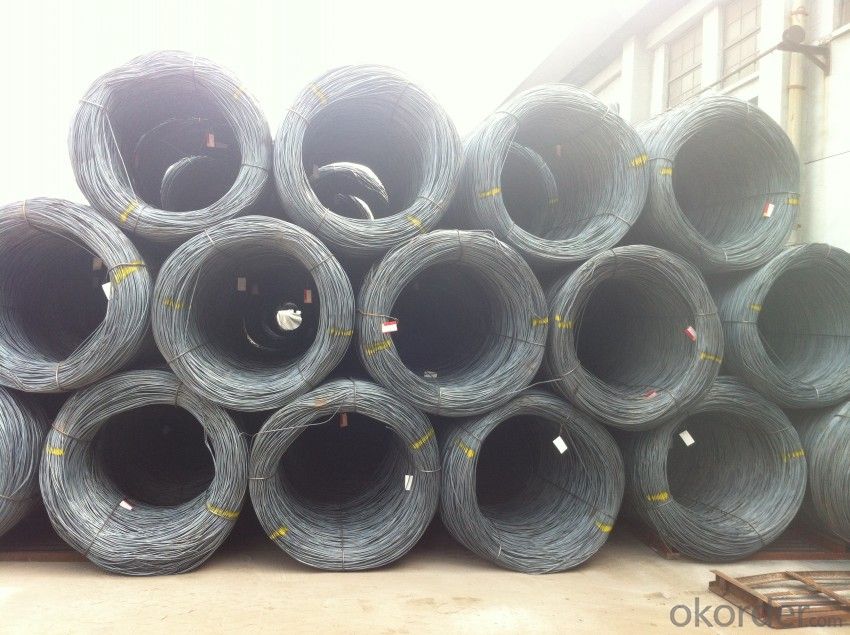
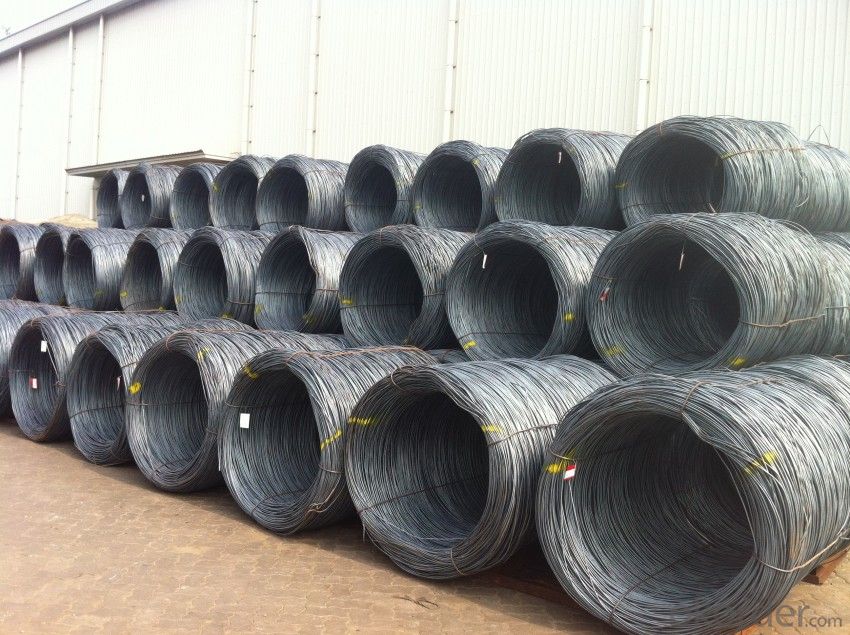
- Q: What are the main factors influencing the choice of steel wire rod order frequency?
- The frequency at which companies place orders for steel wire rods is influenced by several key factors. Firstly, demand and market conditions play a significant role. If there is a high demand for steel wire rods in the market, companies may need to place more frequent orders to meet customer requirements and maintain inventory levels. Additionally, market conditions such as price fluctuations and supply availability can also impact the order frequency. Secondly, the production capacity of the steel wire rod supplier and the lead time required for delivery can affect the order frequency. If a supplier has limited production capacity or a longer lead time, companies may need to place larger and less frequent orders to ensure a continuous supply. Thirdly, inventory management is another factor to consider. Existing inventory levels and storage capacity can influence the order frequency. If a company has limited storage space or wants to minimize inventory holding costs, they may choose to place more frequent orders in smaller quantities. Cost considerations also come into play. The cost of steel wire rods, including the purchase price, transportation, and any applicable taxes or duties, is a significant factor. Companies may analyze the cost of holding inventory versus the cost of frequent ordering to determine the most cost-effective approach. Lastly, the relationship between the company and the steel wire rod supplier can impact the order frequency. A strong and reliable partnership allows for more flexibility in adjusting the order frequency based on changing market conditions or business needs. In conclusion, the choice of steel wire rod order frequency is influenced by demand and market conditions, production capacity and lead time, inventory management, cost considerations, and supplier relationships. Companies must consider these factors to ensure a steady and efficient supply of steel wire rods.
- Q: How are steel wire rods used in the manufacturing of surgical instruments?
- Steel wire rods are an essential component in the manufacturing of surgical instruments due to their strength, durability, and flexibility. These rods are typically made from high-quality stainless steel, which offers excellent corrosion resistance and biocompatibility, making it ideal for medical applications. In the production of surgical instruments, steel wire rods are first selected based on specific requirements such as diameter, tensile strength, and composition. The rods are then subjected to a series of processes, including cutting, shaping, and bending, to form the desired instrument's structure. One common application of steel wire rods in surgical instruments is for creating the shaft or handle. These rods are often shaped into intricate patterns or designs to ensure a comfortable and ergonomic grip for surgeons. The high strength of steel wire rods allows the instruments to withstand repeated use, providing longevity and reliability. Another important use of steel wire rods is in the manufacturing of surgical needles. The rods are drawn down to the required diameter and then sharpened to create the needle's point. The flexibility of steel wire enables the needle to be easily maneuvered during surgical procedures, ensuring precise and accurate incisions. Moreover, steel wire rods can also be utilized in the construction of various surgical tools like forceps, retractors, and clamps. These instruments require a combination of strength and flexibility, which steel wire rods offer, allowing surgeons to perform delicate and intricate procedures with ease. Overall, steel wire rods play a vital role in the manufacturing of surgical instruments, providing the necessary strength, durability, and flexibility required for these essential medical tools. Their use ensures the quality and reliability of surgical instruments, contributing to the advancement of modern healthcare practices.
- Q: What are the main factors influencing the choice of steel wire rod manufacturer?
- There are several main factors that influence the choice of a steel wire rod manufacturer. These factors include: 1. Quality of the product: One of the primary factors influencing the choice of a steel wire rod manufacturer is the quality of the product they offer. Customers look for manufacturers that produce high-quality steel wire rods that meet their specific requirements and standards. This includes factors such as the strength, durability, and consistency of the wire rod. 2. Price: Price is another crucial factor that influences the choice of a steel wire rod manufacturer. Customers compare prices offered by different manufacturers and choose the one that provides the best value for money. However, it is important to consider the price in relation to the quality of the product and the overall service provided by the manufacturer. 3. Reliability and reputation: The reliability and reputation of a steel wire rod manufacturer play a significant role in the decision-making process. Customers prefer manufacturers with a proven track record of delivering high-quality products consistently and on time. Positive customer reviews, testimonials, and references from other trusted sources can greatly influence the choice of a manufacturer. 4. Production capacity and capabilities: The production capacity and capabilities of a steel wire rod manufacturer are important considerations for customers. Depending on their specific needs, customers may require a manufacturer that can produce large quantities of wire rods within a specified timeframe. Additionally, customers may also consider the manufacturer's ability to provide customized wire rod solutions or different variations of the product. 5. Technical expertise and support: Steel wire rod manufacturers with strong technical expertise and excellent customer support are often preferred by customers. Manufacturers that can provide technical guidance, assistance with product development, and after-sales support are seen as valuable partners in the steel wire rod purchasing process. 6. Environmental and sustainability practices: In recent years, environmental and sustainability practices have become increasingly important factors in the choice of a steel wire rod manufacturer. Customers look for manufacturers that prioritize sustainable production methods, minimize waste and emissions, and comply with environmental regulations. Overall, the main factors influencing the choice of a steel wire rod manufacturer are quality, price, reliability, production capacity, technical expertise, and environmental practices. Customers carefully evaluate these factors to ensure they select a manufacturer that can meet their specific requirements and provide a high-quality product and service.
- Q: How is steel wire rod used in the manufacturing of wire forms for agricultural machinery?
- The manufacturing of wire forms for agricultural machinery heavily relies on steel wire rod. This crucial component serves as the raw material that undergoes transformation into various wire forms, including springs, clips, brackets, and hooks. These wire forms play a vital role in ensuring the proper functioning of agricultural machinery. Springs, one of the primary applications of steel wire rod in the manufacturing process, are widely used in agricultural machinery. They provide tension, absorb shocks, and facilitate smooth movement. By coiling steel wire rod into the desired shape and size, these springs contribute to the functionality and durability of agricultural machinery. In addition to springs, steel wire rod is utilized to create clips, brackets, and hooks that are crucial for securing different components of agricultural machinery. These wire forms are shaped, twisted, or bent using the steel wire rod to provide the necessary strength and stability needed to withstand the demanding conditions of farming operations. Furthermore, steel wire rod is renowned for its high tensile strength, making it an ideal material for manufacturing wire forms used in agricultural machinery. It can endure heavy loads, resist deformation, and offer the necessary support and reinforcement to enhance the performance and longevity of the machinery. In conclusion, steel wire rod plays a significant role in the manufacturing of wire forms for agricultural machinery. It is used to create springs, clips, brackets, and hooks, which are essential components for the proper functioning, stability, and durability of agricultural machinery. The high tensile strength of steel wire rod makes it a reliable material choice for manufacturing wire forms capable of withstanding the demanding conditions of agricultural operations.
- Q: How is steel wire rod used in the manufacturing of wire forms for suspension bridges?
- The manufacturing of wire forms for suspension bridges relies heavily on steel wire rod. This component is essential in creating strong and durable wire structures capable of withstanding the immense weight and tension exerted on these bridges. One primary use of steel wire rod is in constructing the main cables of the suspension bridge. These cables bear the weight of the bridge deck and traffic load. Typically, the steel wire rod is twisted or bundled together to form a thick cable that can handle the load. The high tensile strength of the steel wire rod ensures that the cables can withstand the forces without stretching or breaking. Aside from the main cables, steel wire rod is also used in creating other wire forms for suspension bridges. These forms include suspenders, hangers, and cross braces. Suspenders are vertical wires that connect the main cables to the bridge deck, providing additional support. Hangers are horizontal wires that connect the bridge deck to the main cables, evenly distributing the load. Cross braces are diagonal wires that offer lateral stability, preventing swaying or twisting. The utilization of steel wire rod in the manufacturing of wire forms for suspension bridges brings numerous advantages. Firstly, steel is renowned for its exceptional strength and durability, making it an ideal material to withstand the high tension and weight requirements of these bridges. Secondly, steel wire rod is highly resistant to corrosion, guaranteeing the bridge's longevity and reducing maintenance costs. In conclusion, steel wire rod plays a critical role in manufacturing wire forms for suspension bridges. Its strength, durability, and resistance to corrosion make it an essential material for creating the main cables, suspenders, hangers, and cross braces that support and stabilize these remarkable structures.
- Q: What are the different sizes and diameters available for steel wire rod?
- Steel wire rods are available in various sizes and diameters to cater to different applications and industries. The sizes and diameters of steel wire rods typically range from 5.5mm to 20mm, with common sizes being 6mm, 8mm, 10mm, 12mm, and 16mm. The diameter of a steel wire rod refers to the thickness or width of the rod, which determines its strength and load-bearing capacity. The specific diameter required depends on the intended use of the wire rod. Thicker diameters are often used for heavy-duty applications such as construction, while thinner diameters are suitable for lighter applications like fencing or wire mesh. Manufacturers produce steel wire rods with a variety of diameters to meet the diverse needs of industries such as construction, automotive, manufacturing, and agriculture. Depending on the specific requirements of a project or application, customers can choose the appropriate size and diameter of steel wire rod to ensure optimal performance and durability.
- Q: What are the safety requirements for steel wire rod used in elevator wire ropes?
- The safety requirements for steel wire rod used in elevator wire ropes are crucial to ensure the reliable and secure operation of elevators. These requirements are set by various industry standards and regulations to guarantee the strength, durability, and performance of the wire ropes. Some of the key safety requirements for steel wire rod in elevator wire ropes include: 1. Material Quality: The steel wire rod used in elevator wire ropes must meet specific material standards, typically specified by organizations such as the American Society for Testing and Materials (ASTM). These standards define the chemical composition, mechanical properties, and other characteristics of the steel to ensure it can withstand the required loads and stresses. 2. Strength: Elevator wire ropes are subject to significant loads and stresses during operation. Therefore, the steel wire rod used must have a high tensile strength to withstand these forces without breaking. The minimum tensile strength requirements are typically defined by industry standards to ensure the safety of passengers and the elevator system. 3. Fatigue Resistance: Elevator wire ropes undergo repeated bending and flexing during operation, which can cause fatigue failure if the steel wire rod is not designed to resist this. The steel wire rod should have excellent fatigue resistance properties, enabling the wire rope to withstand millions of cycles without degradation. 4. Surface Quality: The surface of the steel wire rod must be smooth and free from any defects or imperfections that could weaken the wire rope. Surface irregularities, such as pits, scratches, or deformations, can act as stress concentration points and reduce the overall strength and safety of the wire rope. 5. Dimensional Accuracy: To ensure proper fit and functionality, the steel wire rod used in elevator wire ropes must meet specific dimensional tolerances. These tolerances include diameter, roundness, and straightness, which are crucial for proper assembly and operation of the wire ropes. 6. Testing and Certification: Manufacturers of steel wire rod used in elevator wire ropes should conduct rigorous testing to verify compliance with safety requirements. These tests may include tensile strength testing, fatigue testing, surface inspection, and dimensional measurements. Certification from recognized bodies or compliance with industry standards, such as ISO 9001, further ensures the quality and safety of the steel wire rod. By adhering to these safety requirements, elevator manufacturers and operators can be confident in the reliability and performance of their wire ropes, ultimately ensuring the safety of passengers and the smooth functioning of elevator systems.
- Q: What are the potential risks and challenges in transporting steel wire rod?
- Careful management is required when transporting steel wire rods as there are various risks and challenges involved. To begin with, the weight and size of the rods can make transportation difficult. These rods are typically heavy and long, necessitating specialized equipment and vehicles for safe transport. If not handled and secured properly, there is a risk of the rods shifting or falling during transit, potentially causing damage to the cargo, the transport vehicle, or even posing a threat to other road users. Moreover, steel wire rods are susceptible to corrosion. Exposure to moisture, humidity, or harsh weather conditions can result in rusting, compromising the quality and strength of the rods. It is crucial to adequately protect the rods during transport to prevent moisture ingress and corrosion. Furthermore, the sharp ends of steel wire rods can present a safety hazard. These rods often have sharp edges or protruding ends, which can cause injuries to workers involved in handling or loading/unloading operations. It is essential to implement proper safety measures and provide protective gear to prevent accidents and injuries. In addition, transporting steel wire rods requires meticulous planning and coordination. These rods are often transported in large quantities, and their dimensions may require special permits or escorts. Routes and schedules must be carefully planned to ensure punctual delivery and avoid any legal or logistical complications. Lastly, theft and pilferage can be a major concern when transporting valuable steel wire rods. Due to their high value, these rods may attract the attention of thieves or unauthorized individuals. To mitigate the risk of theft, security measures such as tracking devices, secure storage facilities, and thorough background checks on personnel involved in the transportation process should be implemented. Overall, by implementing appropriate safety measures, security protocols, and careful planning, the risks and challenges associated with transporting steel wire rods can be effectively managed, ensuring the safe and timely delivery of the cargo.
- Q: How are steel wire rods used in the manufacturing of cables?
- Cables rely heavily on steel wire rods, as they are a crucial component in their production. These rods act as the core material and provide the required strength and durability for different applications. To initiate the cable manufacturing process, careful selection of steel wire rods is essential. Factors such as quality and specific properties including tensile strength, ductility, and corrosion resistance are considered. These characteristics guarantee that the final product meets the desired standards and performs effectively in its intended application. Once the suitable steel wire rods are chosen, they undergo various manufacturing processes like drawing and stranding. Initially, the rods are pulled through a series of dies to decrease their diameter and increase their length. This process, known as wire drawing, enhances the tensile strength and flexibility of the steel wire, ensuring its ability to endure the stresses and strains encountered during cable usage. Following wire drawing, the drawn steel wires are intertwined to form the cable. Multiple steel wires are intricately arranged in a compact and uniform manner through stranding. This creates a strong and flexible structure. The number of wires and their arrangement in the stranding process depend on the specific cable design and application requirements. Furthermore, steel wire rods are often coated or treated with protective materials to enhance their performance. These coatings may include galvanization to prevent corrosion, lubricants to enhance flexibility, or insulation materials to provide electrical insulation properties. These treatments further augment the durability, longevity, and functionality of the cables. In conclusion, steel wire rods play a crucial role in cable manufacturing, providing the necessary strength, flexibility, and durability for dependable and efficient transmission of various signals, power, or data.
- Q: What are the typical applications of steel wire rod?
- Steel wire rod is a versatile material that finds its application in various industries. Some of the typical applications of steel wire rod include: 1. Construction: Steel wire rod is commonly used in construction applications such as reinforcing concrete structures. It provides strength and durability to the construction materials, making them more resistant to cracking and bending. 2. Manufacturing: Steel wire rod is extensively utilized in the manufacturing sector for producing a wide range of products. It is used in the production of nails, screws, springs, cables, ropes, wire mesh, and various other hardware and industrial products. 3. Automotive industry: Steel wire rod is widely used in the automotive industry for manufacturing components like suspension springs, seat springs, wire harnesses, and tire reinforcement. Its high strength and flexibility make it an ideal choice for these applications. 4. Electrical industry: Steel wire rod is used in the electrical industry for producing cables and wires. It provides excellent conductivity and durability, making it suitable for transmitting electric power or signals efficiently. 5. Agriculture: Steel wire rod is utilized in the agricultural sector for various purposes. It is used in fencing, trellis systems, and vineyard wires to provide support and protection to crops and livestock. It is also used in manufacturing agricultural equipment like wire fencing, gates, and animal enclosures. 6. Packaging and fastening: Steel wire rod is employed in the packaging industry for manufacturing wire for packaging purposes, such as baling wire for securing bundles or tying products together. It is also used in fastening applications like wire ties and clips. 7. Furniture and appliances: Steel wire rod is used in the production of furniture and appliances, such as wire shelves, racks, and frames. It provides strength and stability to these products, making them durable and long-lasting. Overall, steel wire rod has a wide range of applications due to its excellent strength, flexibility, and durability. Its versatility makes it an essential material in various industries, contributing to the development and improvement of numerous products and structures.
Send your message to us
Hot Rolled Wire Rods with SAE 1008 in Best Quality
- Loading Port:
- Tianjin
- Payment Terms:
- TT OR LC
- Min Order Qty:
- 25 m.t.
- Supply Capability:
- 10000 m.t./month
OKorder Service Pledge
OKorder Financial Service
Similar products
Hot products
Hot Searches
Related keywords

